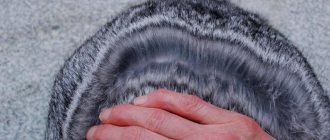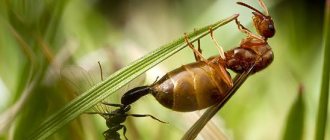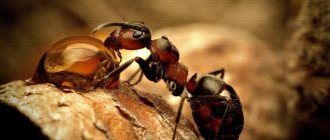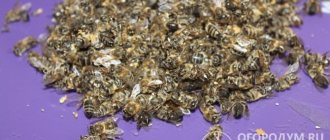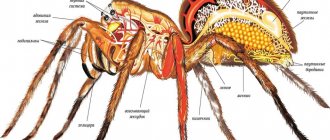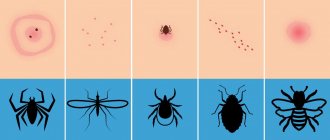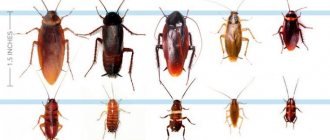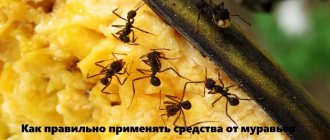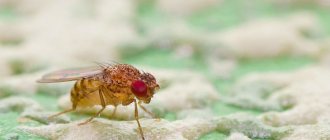Ants are one of the most common insects in nature. They can be found in almost any country, any climate and weather conditions. The only places where they have not yet been recorded are Greenland and Antarctica, as well as some isolated islands in the world's oceans. Ants are social creatures; they cannot exist alone. These insects have their own hierarchy of society, in which each individual occupies a certain place and performs the tasks assigned to it by nature. There is a queen ant whose main task is to perform reproductive functions. Other ants are divided into workers and males. The role of the former is to take care of the anthill family, and the latter is to continue the family line.
In this article we will look at the issue of ant life expectancy. Many people are interested in such information solely from a general educational point of view, and some people who have encountered ants at home or in an apartment want to know how long they will have to endure this scourge.
Conquerors of the globe
These insects are the real conquerors of the Earth.
Today, almost 14,000 species of ants live in nature. Of these, several hundred subspecies live on Russian territory. The number of representatives of the ant population is innumerable. They always live in families or, as they are also called, colonies. Individuals are simply not capable of existing separately. Numerous ant colonies are distributed throughout the world. They can be found everywhere:
- in forests;
- in the steppes;
- in deserts;
- on ordinary city and village streets.
Different types of ants can be found in different habitats
They even reached the permafrost zone. Most subspecies live in natural conditions, but there are also those who settle in human dwellings - houses and apartments.
The only corners of the planet where ants have not yet settled remain:
- Antarctica;
- Greenland;
- some oceanic islands.
In this video you will learn the life expectancy of different types of ants:
Description of the family
Ants are the most evolutionarily advanced family of insects in terms of ethology, ecology and physiology. Their families are complex social groups with a division of labor and developed systems of communication and self-organization, allowing individuals to coordinate their actions when performing tasks that are beyond the capabilities of one individual. Some species of ants have a developed “language” and are capable of transmitting complex information. In addition, many ant species maintain highly developed symbiotic relationships with other insects, fungi, bacteria and plants.
The advantages provided to ants by cooperation have led to the fact that today they are the dominant group of arthropods in terms of numbers. Thus, on 1 km² of savanna in Côte d'Ivoire (Africa) there are almost 2 billion ants, forming approximately 740 thousand colonies. Together with termites (another large group of social insects), ants make up a third of the total biomass of terrestrial animals in the Amazon rainforest. Thus, with an average population density of 800 million ants and 100 million termites per square kilometer, they collectively weigh only half as much as all other land animals in this rain forest. There are fewer of them in areas with temperate climates. In an area of 8 km² in Florida, 76 species of ants from 30 genera were found, and in an area of 5.5 km² in Michigan - 87 species from 23 genera.
The sizes of representatives of the family are varied - from 1 to 30-50 mm or more. Some of the smallest ants include representatives of the genera Monomorium (workers 1-2 mm, females and males 3-4 mm), Mycetophylax (1-3 mm) and Cyphomyrmex (1.5-3 mm) and the species Leptothorax minutissimus - endemic USA, parasitizing colonies of Leptothorax curvispinosus ants and reaching a length of up to 3 mm.
One of the largest representatives of the family is the species Camponotus gigas, the size of workers of which is about 20 mm, males - 18.3 mm, soldiers - 28.1 mm, queens - up to 31.3 mm. Also, the largest ants are the giant ants (Dinoponera gigantea) and Paraponera clavata, reaching a length of 25-30 mm. Males from the African genus Dorylus can reach a length of up to 3 cm, and the queens (queens) in the sedentary phase at the time of maturation of the eggs have a greatly enlarged physogastric abdomen and a total length of up to 5 cm. However, the largest fossil ants in history are the genus Formicium. Their females reached 7 cm in length, and their wings had a span of up to 15 cm.
Lifestyle
The lifestyle of ants also varies according to species and caste.
The following features of the life of these tiny insects can be distinguished:
- Nutrition. The food preferences of individual species can vary significantly. Most arthropods feed on plant and animal foods. For growth and development, ants need protein, which they get by eating insects and atrophic eggs. Those living on the territory of a person’s home or in its immediate vicinity consume traditional food products and food waste.
Arthropods also need carbohydrates, which they consume through a sweet liquid secreted by aphids, dew containing plant sugars. Individual colonies grow mushroom plantations on the territory of anthills.
Most ants living in areas with moderate or severe climatic conditions make abundant reserves for the cold period, which consist of insects, grains, roots
Separately, we need to consider how ants live on the territory of the colony, that is, the anthill.
There is a clear hierarchy according to which individual members of the castes perform the following duties:
- Reapers. Their duties include collecting plant materials such as grains.
- Gravediggers. As the name suggests, the duties of these workers include the delivery of deceased brothers to the conditions of special chambers of the anthill.
- Engineers, builders. These insects not only build housing, but also arrange it.
- Soldiers. Soldiers protect housing from attacks by other insects or other natural enemies.
- Doctors. They are engaged in the treatment of relatives.
- Nurses. The responsibilities of these insects include looking after larvae and eggs. In case of danger, it is these workers who quickly deliver the larvae to safe places.
However, not all arthropods live in large colonies. There are some arthropods that live in relatively small groups.
What do ants eat?
The most important reason for the appearance of ants at home is the search for food. The listed species of ants are omnivorous. They prefer sweet foods, such as sugar or leftover jam, but they may well enjoy a piece of bread or even spices. The main danger ants pose is as carriers of infectious diseases. The most accessible place to look for food is the trash can, in which colonies of pathogenic bacteria grow over time. If you have ants at home, it is important to block their access to garbage - insects can crawl on a variety of surfaces and spread harmful microorganisms.
Reproduction rate
Ant eggs The fertility and viability of the entire colony depends on the queen.
The queen lives on average more than 10 years. In a human apartment, there are optimal conditions for the life and development of new ants, so the queen is able to lay eggs every year. Over the entire period of life, the number of eggs laid by one female exceeds 500 thousand. And in one anthill there can be several oviparous females. The eggs hatch into larvae that are fed by the workers, after which they pupate and within a month and a half a new adult ant is born. Their reproduction rate is very fast; in just a few months they are able to occupy the entire kitchen and move to other rooms.
Description
In nature there are yellow, red, black, red ants, and many of them are not monochromatic, and combine these colors in their coloring.
Red ants from the genus Mohomorium are considered the smallest: the length of working individuals is 1-2 mm, females and males - from 23 to 4 mm. As for the largest representatives, for example, African males of Dorylus can reach 3 cm, and the uterus during the maturation of eggs, due to a greatly enlarged abdomen, reaches five centimeters.
Despite the fact that ants' vision is poorly developed (and some are completely blind), they distinguish vibrations and movement very well. Their vision is successfully replaced by antennae located on the head, which detect chemicals, sense the movement of air masses, and, in addition, with their help, insects transmit and receive signals through touch.
The upper jaws (mandibles) of ants are so strong that they successfully use them to carry food, manipulate various objects, build an anthill and successfully defend themselves. Interestingly, in some species these jaws open 270° and snap shut like traps at speeds of up to 230 km/h.
Family structure
An ant family is a long-term, highly organized community consisting of brood (eggs, larvae, pupa), adult sexual individuals (females and males) and, as a rule, numerous working individuals (sterile females).
Ants form families, the sizes of which vary from several dozen individuals to highly organized colonies consisting of millions of individuals and occupying large territories. Large families consist primarily of sterile, wingless females, forming castes of workers, soldiers, or other specialized groups. Almost all families have males and one or more reproductive females, called queens or queens. Colonies are sometimes called superorganisms because the ants work as one unit.
In ant families there is a division of labor, connections between individuals and self-organization in solving complex problems. Such parallels with human society have long been the subject of research by scientists.
Ant queen
An ant colony has one (monogyny) or several (polygyny) reproductive females, depending on the species and size of the colony—called queens or queens. Females are similar to workers, but differ from them in the structure of their breasts and, as a rule, are larger in size. They have wings that they bite off after fertilization.
In most species, queens and workers develop from fertilized eggs - they have two sets of chromosomes, derived from the sperm and the egg.
The female mates only once during the “nuptial flight”, receiving a supply of the male’s sperm, which is gradually used up throughout her life. The lifespan of a female ant is the maximum for the insect world and can be up to 12-20 years, depending on the species (the record for females of 28 years was recorded in a laboratory nest of Lasius niger). Fertilized females shed their wings and either found a new family or remain in their anthill. Sometimes young females are accepted into other, already existing families of their species. In the first case, the female must choose a place for the nest, prepare the first chamber of the new anthill and begin laying eggs after some time.
Queen ant digs a hole, founding a new family
In some species, females engage in food gathering and are forced to leave the nest. In others, they remain in the nest, maintaining their own existence and raising the first workers at the expense of fat reserves and wing muscles that undergo histolysis. The queen feeds the larvae with a special salivary secretion and/or special “food” eggs. The amount of available food is initially very limited, so a compromise is sought between the number and size of the first workers - they are all small or even dwarf.
It may seem that the queen is the center of the ant family, but in reality it is the worker ants. The more females there are in the anthill, the more “disrespectful” the workers’ attitude towards them is. Worker ants move females from one part of the nest to another, transfer them to other nests for exchange, and kill those whose fertility has become too low. Workers also control the reproduction of individuals in the family: they destroy excess larvae or change their feeding regime to change the ratio of the number of castes in the family.
Males
Males (with some exceptions) are born from unfertilized eggs [60] and are carriers of only one set of chromosomes (haploid), which they receive from the maternal egg.
Males usually have wings, which they use during swarming. Among representatives of the genus Cardiocondyla, in addition to winged ones, wingless males are also known, which compete with each other (with a fatal outcome) for young females in the maternal nest.
The role of males is reduced to fertilizing young winged females. Males usually appear in the anthill shortly before the mating flight and die soon after mating.
Worker ants
The vast majority of individuals in an ant family are workers, who are females with an underdeveloped reproductive system (for comparison, in termites, workers can also be immature males), whose main role is to care for the family. They have no wings, a simplified chest structure, eyes are smaller than those of females or reduced, and in some species they are absent.
Bulldog ant mandibles
Some species are characterized by polymorphism - differences in size, sensitivity of sensory organs and activity among ants of the same species, depending on the tasks they perform in the family.
Often, large worker ants have a disproportionately large head and, accordingly, strong mandibles. These workers are called soldier ants, as their strong mandibles make them very effective in combat, but at the same time, they are still worker ants, and their "responsibilities" are usually slightly different from the "responsibilities" of other workers. Some ant species do not have medium-sized workers, creating a sharp divide between small and large forms. For example, weaver ants have a clear bimodal size distribution. In some other species, worker ants undergo changes throughout their lives.
In addition to polymorphism, worker ants can be divided according to specialization in the family (polyethism). Some ants look after the young (nannies), others participate in the construction of the nest, become foragers, others clean the premises, others store supplies of liquid food (honey barrels), etc.
In some species of ants, workers can lay eggs.
The power of a worker ant increases when working in a group. For example, a worker of a hairy forest ant alone is capable of developing a power of 24.2 erg/sec, and in a pair, each worker develops a power of up to 31.6 erg/sec. In ants of the genus Formica, the brain occupies 0.57% of the body volume.
Types of ants and their lives
The belonging of insects to a certain species is inextricably linked with all the features of their existence, including its duration. As vivid and interesting examples of different lifestyles, we can consider the following representatives of the ant people:
- red forest ones;
- pharaonic;
- tropical (including bulldogs).
Red forest - pest exterminators
Individuals of the red forest species are considered orderlies of mixed forests. And not in vain - the inhabitants of just one large anthill are capable of destroying a wide variety of harmful insects on the territory of a hectare of forest. All day long these useful creatures collect pupae of pests. The loot is in the thousands. Red forest ants feed their own larvae with the collected pupae.
The maximum lifespan of a wood ant is five years
The natural lifespan of this species of ant is limited to five years of age. But in reality, they do not live to see this period and die much earlier. The main reason for the early mortality of these ants is the birds that feed on them. Males, as expected, complete their life cycle a maximum of a month after mating. And the queen has every chance of outliving all the inhabitants of the anthill, but only if she stays at home all the time.
Pharaohs - invaders of human homes
These small two-millimeter creatures, which came from hot countries, do not build anthills or other buildings themselves. They chose people's houses and apartments as their habitat. They usually settle in separate niches and cavities. Having settled in an apartment building, one family of pharaonic ants is able to multiply into a colony of many thousands.
Of all the varieties of ants, pharaoh ants have the shortest life cycle. Insect workers usually live no longer than 2 months, males - about 20 days, queens - within 9 months. However, their short lifespan does not prevent these ants from actively reproducing. During their existence, pharaoh ants produce over 30,000 new individuals. Such high productivity is due to the presence of a large number of queens in one nest.
Tropical and bulldogs are long-lived giants
Despite the longevity record set by a representative of the carpenter species, the champion title for life expectancy was awarded to tropical ants. The maximum age of individuals of this species reaches 22 years. Of course, this applies to queens, and only those of them who are constantly in the anthill.
One of the largest ants in size. Tropical Bulldogs can live up to 22 years
Representatives of tropical ants are very impressive in size; they are among the largest ants in the whole world. Giants from the worker caste can live 5 years, and queens can live about 20 years. This is the most striking example of how the size of an insect and its lifespan are related.
How many years does an ant live?
The life span of ants depends on what species and what caste it belongs to. From birth, the caste of the insect is determined and it does not change throughout its life. Worker ants, queens and males live in one family.
However, not all species of these insects exhibit a strict division into castes. Individuals of black garden and pharaoh ants can change their “specialization” throughout their lives. A newborn ant can take care of larvae and eggs, later - set up a home, and at the end of life - get food.
In addition, the length of an insect's life cycle is affected by its size. It has been noticed that the larger the ant, the more likely it is to live a longer life. The conditions of its life also play a significant role in determining how long an ant will live.
"Brief Life" or Longevity
There is no single answer to the question of the life expectancy of ants. If we consider all the information reliably known to entomologists about how long ants live in nature, then the minimum indicator is five days, and the maximum reaches twenty-eight years - a kind of record by ant standards.
What do ants look like?
The body of an ant (in Latin - Formicidae) consists of three sections: head, chest and abdomen.
All parts of the body are connected to each other by elastic bridges, which makes the ants very flexible, mobile and resourceful. There are three pairs of limbs on the chest. The head is usually large and equipped with powerful mandibles, necessary for grinding food, holding food, or generally for defense. The life cycle of an ant includes the following stages: egg, larva, pupa and adult. It is at the larval stage that the diet of the larva determines who will be born: the queen, infertile females, males, or just worker ants. This entire process takes from 1 to 2 months.
Lifespan of ants by species
Ants are the most common insect species on earth, the total number of which is divided into 13.5 thousand species. And 300 species of them live in Russia. Insects lead a social life and cannot exist alone.
The lifespan of ants is genetically determined depending on their membership in a certain caste, which is determined at birth and does not change throughout their existence: workers, queens and males.
How many years ants live depends on the type and living conditions of the insect. The size of the individual also affects its lifespan: the larger the ant, the greater the chance of living longer.
Red forest ant
Red forest ant
The inhabitants of mixed forests are rightfully considered to be orderlies - a large anthill can protect a hectare of forest from pests. Ants feed their larvae with pupae of harmful insects, collecting several thousand pieces in one day. Colonies of aphids, which are raised by ants to collect the sweet juice produced by insects, can be called harmful.
The life of ants passes in an anthill made of twigs, pine needles, and forest debris. The height of the structure can reach two meters. Insects overwinter in the lower part of the structure, hibernating if the temperature inside is too low.
The life cycle of a working red ant is designed for 5 years, but almost no one lives to reach the deadline set by nature - forest birds love to feast on ants. Males, having fulfilled their function, die within a month. The queen is long-lived while she is in the anthill.
Red forest ants are listed in the Red Book. Forestry staff conducts an annual count of anthills.
meadow ant
meadow ant
The insect is distinguished by its body covered with villi. How do meadow ants live? They make their homes in open areas: forest edges, meadows. Winged females fly out twice a season to fertilize. The lifespan of a meadow insect is the same as that of its red forest counterpart. Ants that spend time in the middle of an anthill have a longer lifespan than those that go outside. The reason is the high mortality rate of working individuals from injuries and predators.
Pharaoh ant
Pharaoh ant
The pharaoh ant was brought from warm countries, so for its housing it chooses human houses in rural and urban areas. Insects do not build an anthill, but adapt cavities in the house for nesting. In multi-apartment buildings, pharaoh ants live in colonies numbering several thousand individuals, belonging to one family with a common leadership. The adult size reaches 3 mm.
The life expectancy of an ant is one of the lowest:
- females live 8-9 months;
- breeding males die within 20 days;
- working individuals exist for about 2 months.
The short lifespan of insects is compensated by a large number of queens in the nest, which can reproduce more than 30 thousand individuals per year.
The average development time for an ant from egg to adulthood is approximately 40 days. In the shortest possible time, pharaoh ants can colonize apartment buildings, creating nests in a place remote from humans.
Black garden ant (Lasius niger)
These ants make their nests in the ground and sometimes in people's houses.
The lifespan of a black garden ant is genetically determined by 3 years, but in reality, within a year, the insect colony is renewed.
Myrmica rubra: red myrmica
Insects of this subspecies are also called ruby ants due to their specific coloring and original chitinous cover. Ants are widespread in the European part, as well as in the Urals and Siberia.
Females of the red myrmica grow up to 6 mm at maturity and have a distinct reddish tint. Males are slightly darker and shorter – up to 5 mm. Anthills are located in the ground: under old logs, stumps and stones.
Myrmics are predators and, in pursuit of prey, paralyze it with poison. For humans, contact with ruby ant acid is quite painful and is accompanied by severe pain and redness of the skin. In the process of life, insects crush wood, thereby creating favorable conditions for the mineralization of cellulose-degrading bacteria.
Red myrmica
Caste
An ant family is a well-coordinated team, each member of which contributes to the overall well-being. The number of individuals in an ant colony is related to the variety of these insects. One family can consist of several dozen individuals or several million “relatives”.
As in any society or group, there is a kind of hierarchy in ant colonies. In ants, it is expressed through the division of individuals into castes, which determine their purpose. According to castes, ants are divided into:
- workers;
- males;
- queens (females).
Representatives of these three castes live in each ant family. Living together in one home, insects perform their prescribed duties throughout their lives. The belonging of an individual to a specific caste is determined from the moment of birth, and it is impossible to change it subsequently.
Ants have one of the most complex social systems in the animal world; caste determines the type of activity of an individual
The worker caste is divided into subcastes - soldiers, builders, foragers (or food earners), "nannies", etc. In most subspecies, individuals are assigned to a specific sub-caste and “work” in one area of activity all their lives. But some species of ants do not have a clear distribution among subcastes.
For example, representatives of the black garden species, as well as pharaoh ants, are capable of repeatedly changing their “profession” throughout their lives, that is, moving from one subcaste to another. An approximate scenario of how this movement might occur:
- Newborns take care of eggs and larvae.
- Having matured, they are engaged in arranging the family home - an anthill.
- With the onset of “old age,” ants search for and obtain food.
The relationship between “specialty” and life cycle
It is the worker ant individuals that people most often encounter. Insects of this caste are unable to fly or reproduce, despite the fact that they are not asexual. Workers are females that never become queens. They only build, protect the home and other individuals, take care of the nest, create comfort and get food.
Representatives of the worker caste live on average from 1 to 3 years. Although science also knows individuals that stand out from the statistical data. For example, pharaoh ant workers live for approximately two months, while bulldog ant workers can reach five years of age.
The lifespan of a worker ant ranges from 1 to 3 years. They are the ones who build and provide the anthill with food.
In working individuals, the effect of size on life expectancy is especially noticeable. Small worker ants live much shorter lives than large ones. Another important factor is the environment. As already noted, inhabitants of regions with cold climates, according to scientists, usually live longer than individuals from tropical areas.
Representatives of the soldier subcaste are predisposed to longer lifespan than other workers. But in fact, they live much less, like any other individuals, who are often forced to leave their homes. Insects leaving the anthill very rarely live out their genetically determined lifespan. Much earlier they die from competing ants or insectivorous predators. Quite a few of them were killed under people’s shoes, not to mention the wheels of cars.
Soldier ants play a protective role in the anthill; genetically they should live longer than workers, but in fact they die faster
It is precisely because of the high mortality rate of ants that come out that they become foragers already at the last stage of existence, that is, when the life cycle enters the final stage, and the individual will soon die in any case.
Ants that spend their entire “life” at home successfully live to the physiological limit. In the nests created by worker ants, representatives of two other castes - males and females - gather every year before the mating flight. Both the first and second can fly and reproduce. They mate in the air.
Participation in the mating process is the main task of males and the only benefit they bring to their family. After fulfilling their assignment, they are overtaken by death - either they are killed by workers as there is no further need, or they die from birds or other insectivores. Therefore, male ants have the shortest eyelid of all individuals - their existence lasts only a few weeks. In certain varieties of ants, the elimination of males is not part of the mandatory program, but only if there are several queens in the anthill.
The queen ant lives longer than other castes. The main task is the production of offspring
After mating, females face a completely different fate than males. They turn into queens - producers of offspring. Ant queens are record holders for longevity. No individual can live as many years as the ants of the queen caste live, no matter what size it is and no matter what favorable conditions it lives in.
The life cycle of the uterus can reach twenty years (maximum). This is 10, or even more, times longer than the lifespan of a working individual. Having given birth to many new individuals, the queens go to “retirement” - they shed their wings and choose an anthill for their permanent residence. Over the course of her life, the queen can leave offspring numbering up to half a million individuals.
It is worth noting that twenty years of age is still not the limit for the uterus. An officially registered case of a queen of carpenter ants reaching the 28-year mark. Moreover, the age was calculated without taking into account the larval stage. This is a record that has not yet been broken.
Short existence
How many years do ants live? It is not possible to answer this question accurately. Their lifespan is determined by several factors. The main ones are the species and caste to which a particular ant belongs. Scientists have only approximate data on this matter:
- An ant, which is a worker species, can live for about 3 years. The smaller the size of the individual, the shorter the time of its existence. Interestingly, insects living in northern, colder regions can boast longer lives.
- Males die quite quickly: just a few weeks after birth. During this time, they manage to complete their main task - mating. As soon as this happens, they are killed by relatives or predators.
- The lifespan of the queen (or queen) is longer than others. In some cases it reaches 20 years.
Some types of ants spend a certain period of time sleeping. During this period, their life processes slow down greatly. Therefore, the active life of such individuals is much shorter.
Who will live longer?
The duration of existence of a particular representative of a given species may be influenced by other factors:
- Variety. There are bulldog ants and pharaoh ants. The first individuals, which belong to the working caste, live about 5 years, but the life of workers of the second type is only 2 months.
- Caste. Those who perform the duties of soldiers in the anthill will live longer than those who take care of the queen and offspring. The uterus, as mentioned above, lives the longest. The record is considered to be a lifespan of 28 years.
- Job. Individuals who spend most of their lives in the anthill will live longer than those who “serve” as soldiers or breadwinners. The latter are at greatest risk. They may die from the clutches of predators or simply not live to see the maximum possible life.
- Larva. The lifespan of ants also includes the period when they were at the larval stage.
- Ambient temperature. Individuals living in the cold are so-called long-livers.
Record holders
- Bulldog ants are considered to be long-lived. They live for about 5 years, and their queens live for about 20.
- The queen of a species of African wandering ants broke the record for its size. It can reach 5 cm in length. Every day she lays about 120,000 eggs (2 eggs per second).
- Parasitic ants live the shortest of all. They exist and develop by feeding on supplies in other people's anthills. Representatives of this species die within a few weeks after birth.
What determines the lifespan of an ant in nature?
How long an ant lives is determined not only by caste, but also by external factors. Scientists have found that the lifespan of insects directly depends on climatic conditions.
Ants from warm countries live longer than their counterparts from northern regions, since the latter spend the winter in a state of suspended animation and emerge from it only when favorable conditions exist. This means that they lead an active lifestyle much less than insects from warm regions.
Factors influencing the lifespan of ants
In addition to specialization and species, the lifespan of ants is also influenced by the following factors:
- region of residence;
- insect sizes;
- nature of the work;
- species features.
It has been observed that in cooler countries, ants live longer. This is explained by the fact that the development time of larvae is extended due to slower metabolism. In addition, in winter, some species hibernate, which also lengthens their lifespan.
Body size is another of the most significant factors. The larger the insects, the longer they tend to live. Accordingly, small ants will live less.
Life expectancy is not least influenced by the nature of the work that a particular ant is assigned to perform. Individuals engaged in the quiet work of renovating their homes and raising the younger generation, as a rule, live a long time. Soldiers and miners die before the allotted time from the jaws of enemies and accidents.
It has also been noted that insects leading a measured, sedentary life are able to live longer than wandering nomads. The high mortality rate from injuries and starvation among nomads probably plays a big role in this.
A little about the life of an anthill in general
Almost every anthill begins with a small hole or cavity under a stone in which a fertilized female hides. Without feeding or showing itself on the surface, she lays her first eggs and feeds her first helpers with special trophic eggs.
And only after the first offspring turn from larvae into adult ants, the female will begin to receive food from them. They will begin to care for the eggs and expand the anthill.
For many ants, all the garbage from the anthill is piled up near the exit, and large piles are formed from it. Such anthills are known in our forests - they can reach a height of 2 m.
The lifestyle of ants living in northern latitudes involves a long winter experience. In those areas where positive temperatures remain underground, ants do not hibernate, but prepare supplies for the winter, and the anthill continues to live normally throughout the winter. In this case, the female stops laying eggs, and all exits from the anthill are walled up.
Where the ground freezes, ants can spend the winter in a state of hypothermia. They set records here too: the larvae of Kamchatka ants can cool down to minus 50°C. Of course, during this period the insects do not move, and their internal organs practically do not work.
Usually, once a year, sexual individuals hatch in an anthill, which simultaneously fly out, swarm, mate, and the females then disperse in search of new places for anthills. Sometimes a very large family can split up, and part of it goes to a new place to organize a new colony.
In general, ants are an example of altruism and complete self-sacrifice for the good of the colony. Each of them is ready to die defending the anthill from the enemy, and each of them works selflessly throughout his short or long life. It is not surprising that ants are the most numerous insects on Earth today, surpassing any other group of arthropods in the number of individuals.
Life of an ant community
The small anthill that has been built is constantly expanding. Both its above-ground and underground parts are increasing. Construction never stops, so worker ants work all day long. The structure of an anthill is quite complex and includes not only a lot of transitions, but also the following elements:
- outer covering of branches and leaves;
- room heated by the sun;
- ventilation ducts;
- lower wintering chamber;
- grain storage;
- underground garbage dump;
- the queen's chambers;
- children's;
- storage room for captured caterpillars and insects;
- departments for keeping aphids.
The larger the colony, the more departments there are in such a stationary house. Ants overwinter in deep underground passages. The temperature there does not drop below 3-5 °C. Since ants reproduce continuously in order to constantly maintain the life of the colony, huge communities have several royal chambers. In appearance, any female is a constantly reproducing monster. Large anthills need several queens. The number of queens can reach 5-10 individuals to provide the colony with offspring. The development of the ant depends on the feeding habits of the larval form. Reproduction does not stop for a single day throughout the warm season.
Ant eggs are unique. Representatives of all castes immediately emerge from them, who subsequently build the anthill and perform work for its normal functioning. Working individuals create a nest and care for the new generation. They are small in size. Larger individuals are foragers that participate in the search for food. Another caste is represented by soldiers. Ants attack any creature that poses a danger to the community and are ready to die in the fight against the enemy. It is very difficult to list what ants eat in nature, since these insects are omnivores. The creatures' diet includes:
- any insect;
- juices and pulp of berries;
- seeds;
- carrion;
- some types of plants;
- dew;
- tree resin.
These insects can attack prey of any size. Insects can even cope with predators of the microcosm. An ant bite allows you to create a wound for injecting poison.
From early morning until late at night, foragers scour in search of food. Next, the food goes to the queen, larvae and other members of the colony. These creatures do not need to sleep, but they do not work at night.
Any forager can carry as much as the ant weighs. In some cases, these creatures carry loads that are 5-10 times their own weight. Recently, scientists were able to determine how much an ant weighs after drinking nectar or juice. They refer the nutrient fluid to other relatives. Therefore, the weight of the ant fluctuates significantly.
/wp-content/uploads/2016/12/video.mp4
Representatives of some species can winter even in the harshest conditions, where the cold persists for 9 months a year. How ants prepare for winter has already been studied quite well. Insects clog all entrances and move to the lower sections, where the temperature is maintained, which is not destructive for insects. Ants do not sleep, their metabolic processes simply slow down.
Records of long-lived ants
The record holders for the longest life span are individuals living in tropical latitudes. A distinctive feature is its large dimensions.
The permanent habitat is an anthill nest built by relatives. The bulldog ant, being a functional worker, lives for five years, the queen of this species is twenty to twenty-two years.
The shortest life span is for parasitic ants, which do not have their own anthills, but live in already built nests, feeding on other people’s food supplies. Nature has given these individuals two to three weeks.
Features of behavior and lifespan of house ants
The appearance of insects in the home begins with the reconnaissance stage. Individual individuals, whose function is to survey new territories, are the first to go forward for reconnaissance. By leaving a scent, they show the way for workers where to move in search of a favorable habitat.
Having discovered several insects in your home, at first glance, moving chaotically, you can confidently say that the main forces of parasites will come for them. Insects are primarily attracted to food with a sweet taste.
House ants, being small in size, penetrate apartments using:
- cracks;
- cracks;
- holes;
- exhaust wells.
Possessing an excellent sense of smell, the target of insects will always be the kitchen. Urban, as well as rural housing, presupposes the presence of parasites. They choose breeding sites in hard-to-reach places.
It is very difficult to get rid of pests in apartment buildings. In empty housing, where there is no food, ants do not stay long, moving closer to food sources.
Note! House ants have developed a mechanism for maintaining the species. The main one is the female who lays a sufficient number of eggs. If the birth of new individuals decreases, then the males kill such a queen and choose a new one.
The main characteristics of the existence of house ants:
- the life span of the main female with stable reproduction of offspring is fifteen years;
- individuals classified as workers live a maximum of sixty days;
- ants performing the functions of security guards and construction workers live no more than two years.
These insects, like most other species, are perceived by humans as harmful creatures. This judgment is valid only for residents living in residential premises.
Good to know! For individuals located in the territories of garden plots and country houses that build their nests in the ground, a positive characteristic will be given, since the soil from their presence becomes loose and the habitat area is clean. Add a comment Cancel reply
Social organization
The division of labor between all individuals of the family ensures coordination of the implementation of assigned tasks and goals
Adaptation to the environment
They easily adapt to changes in the environment and place of residence - their high level of organization allows them to quickly and efficiently carry out resettlement and development of a new territory. They also have the ability to master all kinds of resources - soil, wood, stones, foliage.
Hard work
Observers are always surprised by this property of insects, since from the outside it looks like chaotic movement. However, each individual has a specific task, which it hurries to complete flawlessly:
- building a nest;
- security;
- maintaining order and cleanliness;
- food preparation;
- the hassle of caring for sick family members and future generations;
- other daily work.
If it is noticed that a worker is working and performing his duties poorly, such a member of the colony will be immediately expelled. Similar demands are put forward to the queen: if there are few offspring, the queen will be re-elected.
An amazing fact about ants can also be confidently called the ability of these little workers to lift a load weighing tens of times their own.
Training the younger generation
Among the inhabitants of the nest there is a certain category of insect mentors who select and train the growing individuals. Students repeat classes and practice skills with their teacher, the tasks are constantly becoming more difficult.
Wars and slaves
Some species in families have a separate category of slave individuals - these are captive pupae captured during an attack on another nest. They are assigned the same functions as in their own family.
Burial
In order to prevent the spread of diseases and infections and to maintain the cleanliness of the nest, responsible workers move the bodies of dead family members outside the anthill. The scientific name for this process is necrophoresis.
Caring for fellow tribesmen
Ants tend to take care of sick or weakened family members; they provide them with food and drink until they recover.
Interesting Facts
Among the most interesting facts about ants are the following:
- Ants are considered the most ancient insects. Their history goes back about 100 million years.
- Scientists have data on more than 8,500 species of ants.
- These insects are considered the most developed. In this respect, they came closer to man than others.
- The main job of each individual is to prepare for winter. At night, all supplies are hidden in the house, and in the morning they are taken out into the air to dry. Ants are very sensitive to weather changes, so they will never dry out supplies before it rains.
- Each anthill has its own hierarchy.
- An ant colony always moves in a strictly defined order. She will find her way to her home under any circumstances.
- Food is distributed among family members by the queen.
It should be noted the extraordinary sense of justice of insects of this species. They will never abandon their sick or crippled brothers, they will take care of them and even feed them.
Needless to say, ants are an example of altruism and hard work. They are fair and very organized. Even people have something to learn from them.
Sources
- https://vrediteli24.ru/muravi/s-chem-svjazana-prodolzhitelnost-zhizni.html
- https://ru.wikipedia.org/wiki/%D0%9C%D1%83%D1%80%D0%B0%D0%B2%D1%8C%D0%B8
- https://hankel.ru/sredstva/skolko-let-zhivut-muravi.html
- https://muravdom.ru/help/o-muravyax/skolko-zhivut-muravi/
- https://bezbukashek.ru/muravi/skolko-zhivut-muravi
- https://WikiParazit.ru/muravi-i-termity/skolko-zhivut-muravi-v-prirode.html
- https://deziplan.ru/muravi/o-muravyax/skolko-zhivut-muravi.html
- https://stopklopu.com/skolko-zivut-muravi-raznyh-vidov/
